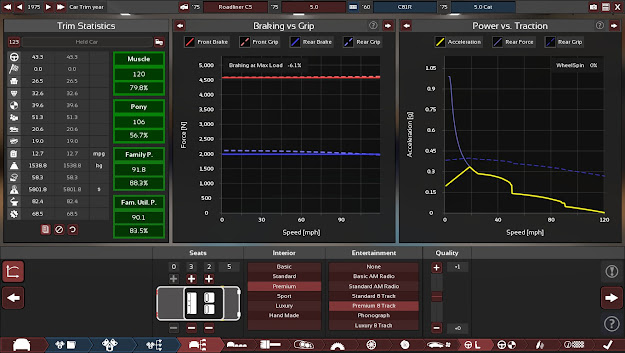Confessions of an Automationeer, Part 96: Automatic or Manual?
Choosing a transmission type in Automation depends primarily on the demographic(s) you want your car to be aimed at. Not only that, it will also affect various stats on your car. For most of the game, you can choose between manual or automatic transmissions, although sequential and dual-clutch gearboxes become available towards the end of the game. With this in mind, let's explain the pros and cons of each type, and when to use them.
Automatic For The People
Automatic transmissions rely on a torque converter to allow the driver to accelerate and brake without having to change gears. As such, they are generally less efficient than equivalent manual gearboxes, although this can be mitigated or even negated by the option to use an advanced computer-controlled unit and/or more gear ratios in later years. On the other hand, not having to shift manually means that an automatic transmission yields vastly superior drivability and comfort compared to a manual transmission, at the expense of reduced sportiness and increased costs. Therefore, it is recommended to select an automatic transmission if the car you are building is intended for demographics in which comfort and drivability are major priorities.
All in the Manual
A manual transmission requires the driver to engage the clutch and move the shifter into a desired position in order for it to change gears. This requires more effort than with an automatic gearbox, and therefore reduces drivability and comfort. However, by making the driver feel more engaged with the act of driving, it improves sportiness, and the absence of a torque converter usually leads to improved fuel economy. In addition to this, a manual gearbox is cheaper, lighter, and easier to service than an equivalent automatic one. For these reasons, manual transmissions are generally recommended in demographics which place a strong emphasis on sportiness, especially until sequential and dual-clutch gearboxes become available.
Other Transmission Types
Two other transmission types become available for selection late in the game: sequential and dual-clutch. The former dispenses with a traditional clutch entirely and can only shift between adjacent gears. The latter uses two sets of clutches (one for odd-numbered gears and another for even-numbered gears) instead of just one. Neither of them quite as smooth as an automatic gearbox, but they tend to improve acceleration compared to a similarly configured manual gearbox. As such, they are commonly found in high-performance and/or upmarket trims in which more comfort is desired than can be provided with a manual transmission, without sacrificing too much sportiness. However, on lower-end cars, the added mechanical complexity of these gearbox types tends to make them less worthwhile compared to conventional manual or automatic gearboxes.
Where's the CVT?
Some of you may be wondering why Automation does not support continuously variable transmissions. The reason is simple: their method of operation (which involves a set of cones linked together via rubber belts) allows for an infinite range of ratios. However, this is simply too complex to properly simulate in Automation. Therefore, you won't find a CVT in the game at all, nor are there any plans to include it at present.
Conclusion
Regardless of what kind of car (or truck, or van) you are building, your choice of transmission type can make or break your build. However, it alone is not the only factor. Gear spacing and final drive ratios are also important factors in determining the stats, competitiveness and performance of your vehicle. That, however, is best reserved for another chapter, given that I originally wrote this post with the intention of discussing transmission types in general.



















